#Akatsuki spacecraft
Text
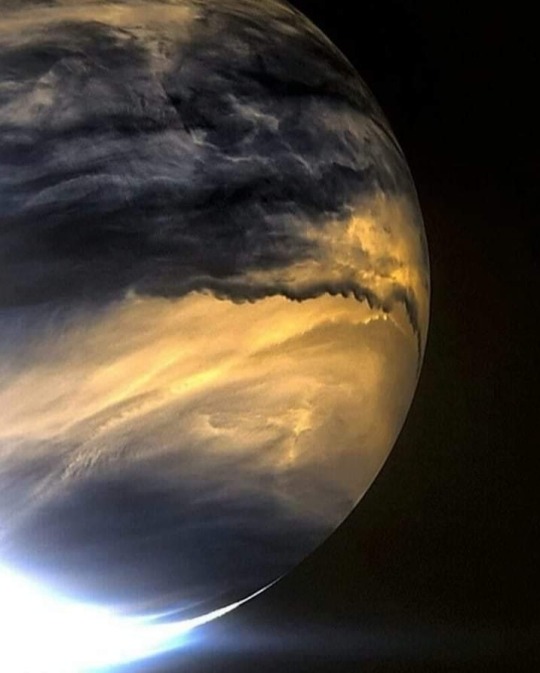
Clearest image ever taken of Venus.
—
Venus at Night in Infrared from Akatsuki
Image Credit: JAXA, ISAS, DARTS; Processing & Copyright: Damia Bouic
EXPLANATION:
Why is Venus so different from Earth? To help find out, Japan launched the robotic Akatsuki spacecraft, which entered orbit around Venus late in 2015 after an unplanned five-year adventure around the inner Solar System.
Even though Akatsuki was past its original planned lifetime, the spacecraft and instruments were operating so well that much of its original mission was reinstated.
Also known as the Venus Climate Orbiter, Akatsuki's instruments investigated unknowns about Earth's sister planet, including whether volcanoes are still active, whether lightning occurs in the dense atmosphere, and why wind speeds greatly exceed the planet's rotation speed.
In the featured image taken by Akatsuki's IR2 camera, Venus's night side shows a jagged-edged equatorial band of high dark clouds absorbing infrared light from hotter layers deeper in Venus' atmosphere.
The bright orange and black stripe on the upper right is a false digital artifact that covers part of the much brighter day side of Venus.
Analyses of Akatsuki images and data has shown that Venus has equatorial jet similar to Earth's jet stream.
➡️ https://apod.nasa.gov/apod/ap180130.html
34 notes
·
View notes
Text
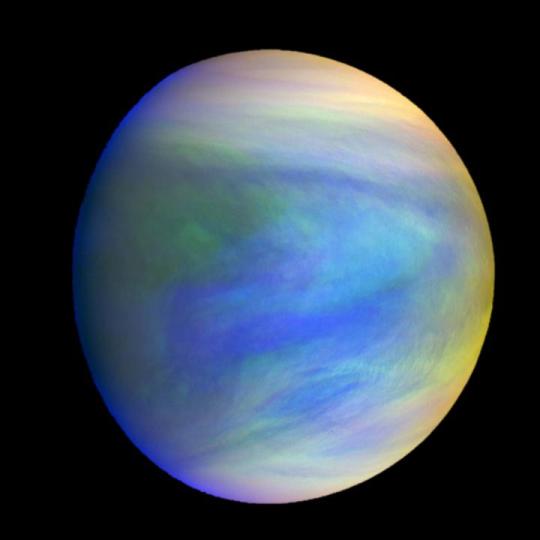
Planet Venus as seen by the Japanese spacecraft Akatsuki built by Institute of Space & Astronautical Science/Japan Aerospace Exploration Agency
4K notes
·
View notes
Text
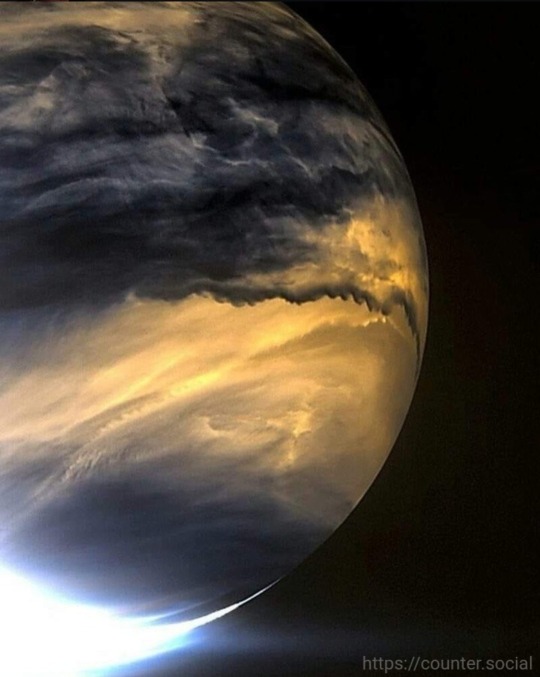
Venus captured by the Japanese Akatsuki spacecraft...
0 notes
Text

Venus in Ultraviolet from Akatsuki spacecraft
Image Credit: JAXA, Planet-C Project Team; h/t: Mehmet Hakan Özsaraç
2K notes
·
View notes
Photo
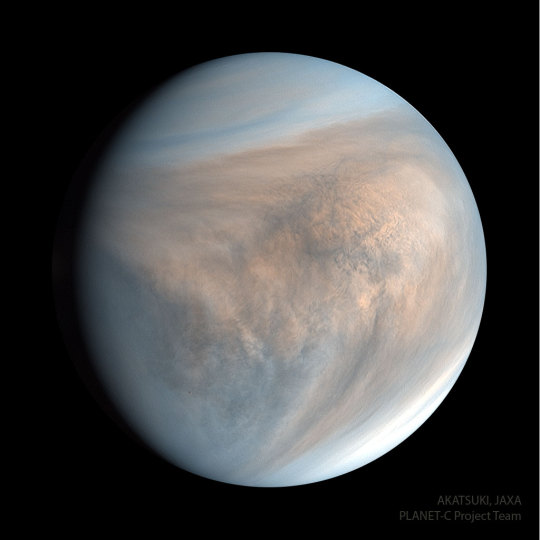
2023 July 3
Venus in Ultraviolet from Akatsuki
Image Credit & Copyright: JAXA, Planet-C Project Team; h/t: Mehmet Hakan Özsaraç
Explanation: Why is Venus so different from Earth? To help find out, Japan launched the robotic Akatsuki spacecraft which entered orbit around Venus late in 2015 after an unplanned five-year adventure around the inner Solar System. Even though Akatsuki was past its original planned lifetime, the spacecraft and instruments were operating so well that much of its original mission was reinstated. Also known as the Venus Climate Orbiter, Akatsuki's instruments investigated unknowns about Earth's sister planet, including whether volcanoes are still active, whether lightning occurs in the dense atmosphere, and why wind speeds greatly exceed the planet's rotation speed. In the featured image taken by Akatsuki's UVI camera, the day-side of Venus is seen shown with planet-scale V-shaped cloud pattern. The image displays three ultraviolet colors and indicates a dip in the relative abundance of sulfur dioxide shown in faint blue. Analyses of Akatsuki images and data has shown, among other discoveries, that Venus has equatorial jet similar to Earth's jet stream.
∞ Source: apod.nasa.gov/apod/ap230703.html
84 notes
·
View notes
Text
Venus Is Not Nekkid
aka what does Venus really look like?
Ok so you've probably seen pics of Venus like:

which is amazing 1990s radar data from NASA's Magellan spacecraft that discovered its surprisingly young, almost crater-free surface and fissures and lava flows and shield volcanoes:
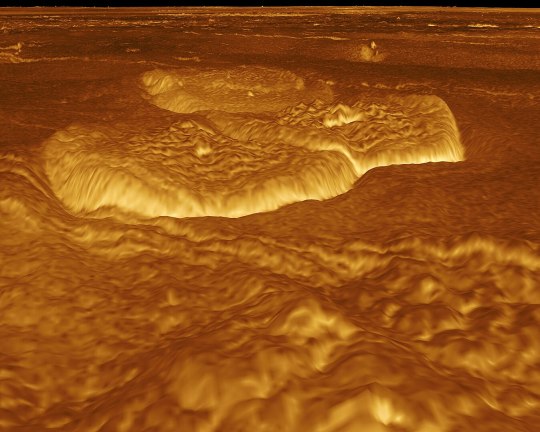
Which was a vast improvement, because apart from 6 photos of the surface by Russian landers asking "why me?", all we had before were grainy Mariner & Pioneer images from the 1970s showing Venus wrapped in featureless clouds in visible light or striped in ultraviolet:
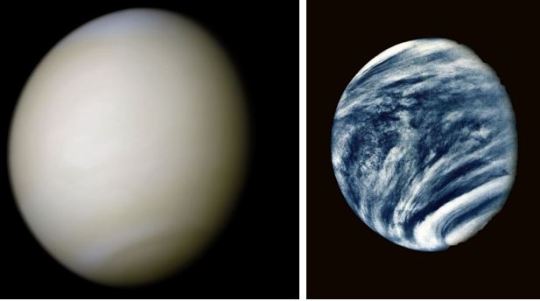
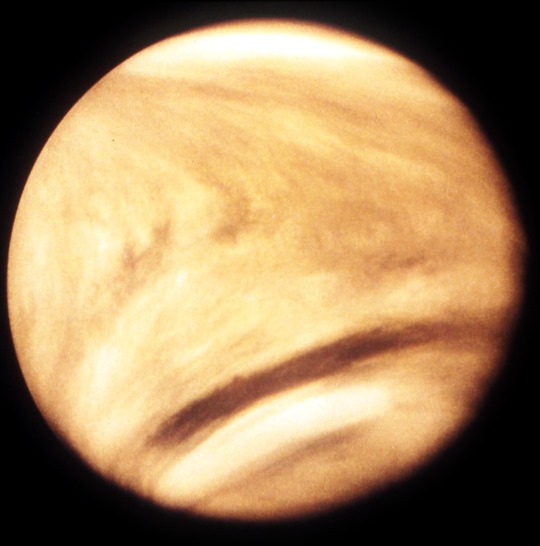
Magellan's radar peered through the clouds to reveal a surface less than 500,000 years old. Without plate tectonics to release heat, hotspots ooze continually, resurfacing the planet in a way that may resemble primitive Earth before plate tectonics.
More terrifyingly, Venus may have been habitable for billions of years until it had a massive flood lava catastrophe like the Earth at the end of the Permian, when 95% of life on our planet died. Except on Venus it was even worse, setting off a runaway greenhouse effect that boiled away the oceans.
Most solar system "family portraits" show Venus with Magellan's false-color radar data, naked, stripped of her thick blanket of clouds:
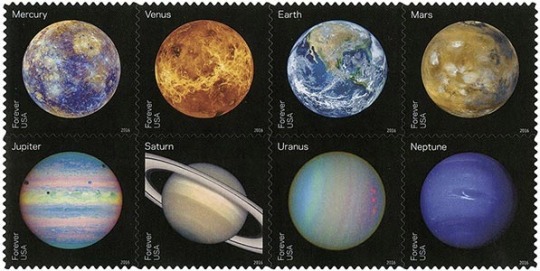
US "Views of Our Planets" stamps (Mercury also false color, Jupiter & Uranus UV I think)
But that's not how Venus looks through a backyard telescope. She's a shining white pearl, which was why the Greeks & Romans recognized her as Aphrodite/Venus.
In 2020, JPL engineer Kevin M Gill reconstructed a visible-spectrum portrait of Venus from old 1974 Mariner 10 probe data using UV and other odd wavelengths:
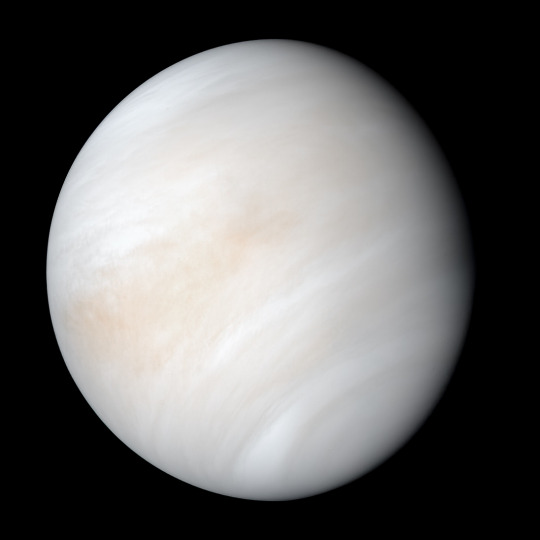
See this writeup on the image with a discussion of Venus' crazy clouds racing around the planet like a toxic hurricane.
A whole community of astronomers and image wizards has grown up hunting through old missions for data they can crunch and de-noise with data processing tools to create new, better images. Space agencies have taken note and now post data for them to play with.
So when 2015 Japan's dogged Akatsuki spacecraft finally made it to Venus after several mishaps, we got its first [UV images]:

Then they started posting raw data from all their instruments (UV and near-IR, because a white pearl is pretty but not as useful for science) and the image wizards went to work.
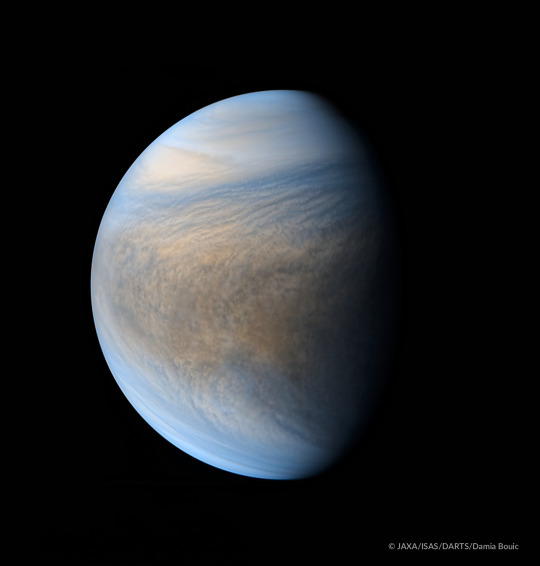
[two UV images combined by Damia Bouic]
Citizen scientist Damia Bouic has a whole blog post of gorgeous Venus images she's processed from Akatsuki data: Here's just a few. They're false color to bring out details, but I think (?) she's using the visible-spectrum colors of Venus for the color and the UV and/or IR data for saturation and brightness.
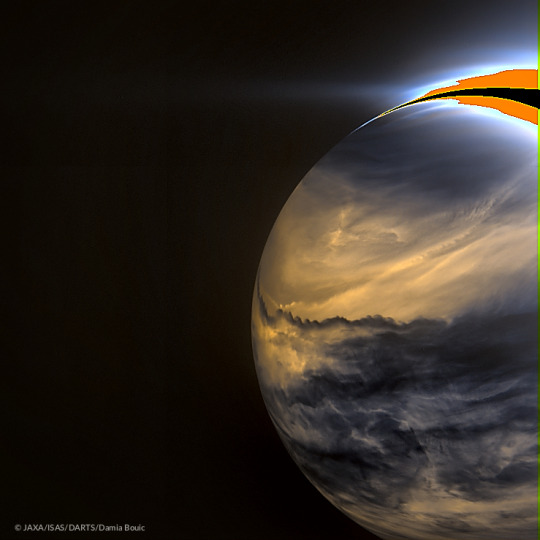
Venus' night side in infrared (detects heat). Check out that funky wave. clouds at the equator move the fastest, but I'm not sure what's causing that.
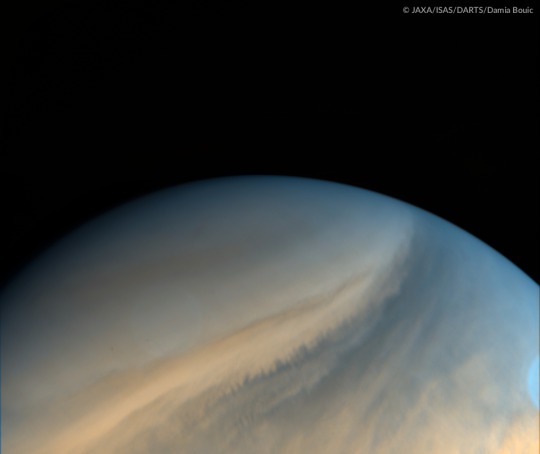
Another UV image processed by Damia Bouic
TL;DR: Venus is Beauty in visible light, the Beast on the surface, and I guess you'd call UV/IR views "I have a bad feeling about this."
131 notes
·
View notes
Text
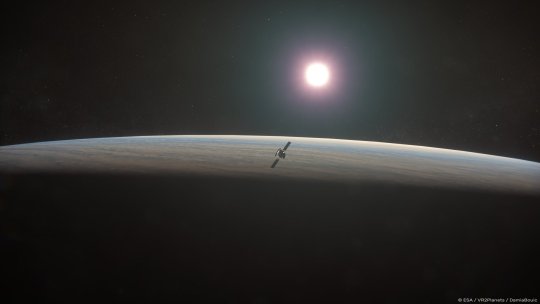

ESA approves EnVision
ESA's next mission to Venus was officially "adopted" today by the Agency's Science Program Committee. EnVision will study Venus from its inner core to its outer atmosphere, giving important new insight into the planet's history, geological activity and climate.
Being adopted means that the study phase is complete and ESA commits to implementing the mission. Following selection of the European industrial contractor later this year, work will soon begin to finalize the design and build the spacecraft. EnVision is foreseen to launch on an Ariane 6 rocket in 2031.
"Since the mission was selected back in 2021, we have advanced from broad science goals to a concrete mission plan," says ESA EnVision study manager Thomas Voirin. "We're very excited about moving to the next step. EnVision will answer longstanding open questions about Venus, arguably the least understood of the solar system's terrestrial planets."
Venus is Earth's closest neighbor—much closer than Mars—and very similar to our home planet in mass and size. Unlike Earth, however, it is not a pleasant place to visit. Of the solar system's rocky bodies, it has the densest atmosphere, and it is completely covered by layers of thick clouds made mostly of sulfuric acid. The surface of Venus is a scorching 464°C on average, with a crushing air pressure 92 times bigger than we experience on Earth's surface. This leaves us to wonder: How and when did Earth's twin become so inhospitable?
Science with EnVision
The measurements EnVision makes will help unravel key mysteries of our hot neighbor. For example, EnVision will reveal how volcanoes, plate tectonics and asteroid impacts have shaped the Venusian surface, and how geologically active the planet is today. The mission will also investigate the planet's insides, collecting data on the structure and thickness of Venus's core, mantle and crust. Last, it will study the weather and climate on Venus, including how they are affected by geological activity on the ground.
"Special to EnVision is the mission's approach to studying the entire planet as a system. It will investigate Venus's surface, interior and atmosphere with unprecedented accuracy, allowing us to understand how they work and interact with each other. For example, EnVision will use multiple measurement techniques to search for signatures of active volcanism at the surface and in the atmosphere," explains Anne Grete Straume-Lindner, the mission's project scientist.
To enable this holistic investigation, EnVision will carry an extensive set of scientific instruments. It will be the first mission to directly probe beneath Venus's surface, using its subsurface radar sounder. A second radar instrument, VenSAR, will map the surface with a resolution down to 10 meters and determine properties such as surface texture. Three different spectrometers will study the make-up of the surface and atmosphere. And a radio science experiment will use radio waves to study the planet's internal structure and properties of the atmosphere.
Strong heritage and fruitful cooperation
EnVision will join ESA's science fleet of solar system explorers. These missions address two top-level science themes of ESA's Cosmic Vision 2015–2025, namely: What are the conditions for planet formation and the emergence of life? and How does the solar system work?
It will be the second European mission to Venus. ESA's Venus Express (2005–2014) focused on the planet's atmosphere, but also made dramatic discoveries that pointed to possible volcanic hotspots on the planet's surface. The study of the atmosphere has continued with JAXA's Akatsuki mission, which is still actively tracking atmospheric movement and Venusian weather.
Longer ago, NASA's Mariner and Pioneer Venus missions (1960s and 1970s), the Soviet Union's Venera and Vega missions (1960s to 1980s), and NASA's Magellan radar mapping mission (1990–1994) painted a picture of a dry world, with landscapes shaped by volcanoes and intense geological activity. They discovered vast plains marked by lava flows, bordered by highlands and mountains. EnVision's VenSAR instrument, expected to be contributed by NASA, will map the Venusian surface at a much higher resolution than Magellan, distinguishing surface features more than ten times smaller.
This time around, EnVision will not be alone on its trip to Venus. Expecting a fruitful collaboration, NASA has also selected two new missions to Venus as part of its Discovery Program: DAVINCI (Deep Atmosphere Venus Investigation of Noble gases, Chemistry, and Imaging) and VERITAS (Venus Emissivity, Radio Science, InSAR, Topography, and Spectroscopy). Together, EnVision, DAVINCI and VERITAS will provide the most comprehensive study of Venus ever.
TOP IMAGE....Artist impression of ESA's EnVision mission at Venus. Credit: ESA/VR2Planets/Damia Bouic
LOWER IMAGE....EnVision science: what will the mission observe? Credit: ESA (acknowledgement: work performed by ATG under contract to ESA), CC BY-SA 3.0 IGO
3 notes
·
View notes
Photo
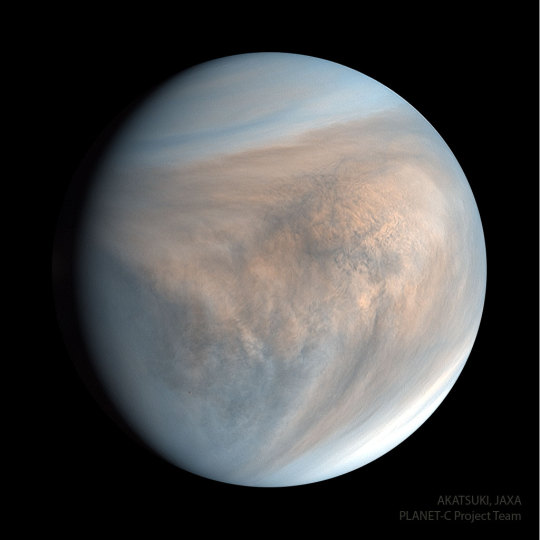
via NASA https://ift.tt/LNcm52M Why is Venus so different from Earth? To help find out, Japan launched the robotic Akatsuki spacecraft which entered orbit around Venus late in 2015 after an unplanned five-year adventure around the inner Solar System. Even though Akatsuki was past its original planned lifetime, the spacecraft and instruments were operating so well that much of its original mission was reinstated. Also known as the Venus Climate Orbiter, Akatsuki's instruments investigated unknowns about Earth's sister planet, including whether volcanoes are still active, whether lightning occurs in the dense atmosphere, and why wind speeds greatly exceed the planet's rotation speed. In the featured image taken by Akatsuki's UVI camera, the day-side of Venus is seen shown with planet-scale V-shaped cloud pattern. The image displays three ultraviolet colors and indicates a dip in the relative abundance of sulfur dioxide shown in faint blue. Analyses of Akatsuki images and data has shown, among other discoveries, that Venus has equatorial jet similar to Earth's jet stream.
3 notes
·
View notes
Text
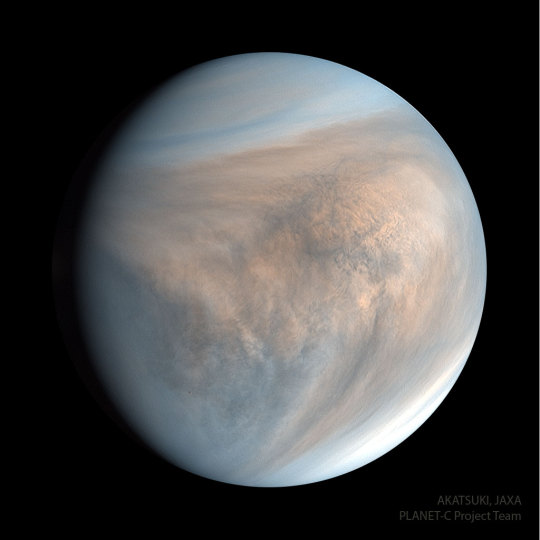
Venus as captured by JAXA's Akatsuki spacecraft 🚀
2 notes
·
View notes
Photo
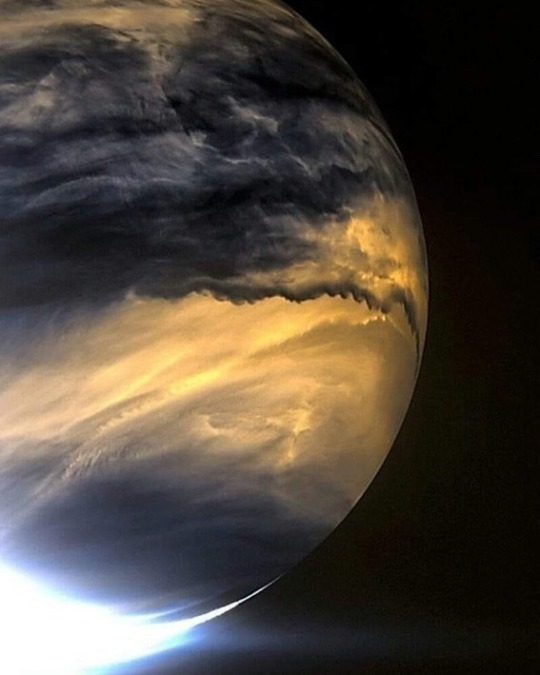
This view of Venus was acquired by the Japanese Akatsuki spacecraft's IR2 camera, which observes—among other things—the warmth of the planet's atmosphere on its nocturnal side.
2 notes
·
View notes
Text
Events 12.7
1962 – Prince Rainier III of Monaco revises the principality's constitution, devolving some of his power to advisory and legislative councils.
1963 – Instant replay makes its debut during the Army-Navy football game in Philadelphia, Pennsylvania, United States.
1965 – Pope Paul VI and Patriarch Athenagoras I simultaneously revoke mutual excommunications that had been in place since 1054.
1971 – The Battle of Sylhet is fought between the Pakistani military and the Mukti Bahini.
1971 – Pakistan President Yahya Khan announces the formation of a coalition government with Nurul Amin as Prime Minister and Zulfikar Ali Bhutto as Deputy Prime Minister.
1972 – Apollo 17, the last Apollo Moon mission, is launched. The crew takes the photograph known as The Blue Marble as they leave the Earth.
1982 – In Texas, Charles Brooks Jr., becomes the first person to be executed by lethal injection in the United States.
1982 – The Senior Road Tower collapses in less than 17 seconds. Five workers on the tower are killed and three workers on a building nearby are injured.
1983 – An Iberia Airlines Boeing 727 collides with an Aviaco DC-9 in dense fog while the two airliners are taxiing down the runway at Madrid–Barajas Airport, killing 93 people.
1987 – Pacific Southwest Airlines Flight 1771, a British Aerospace 146-200A, crashes near Paso Robles, California, killing all 43 on board, after a disgruntled passenger shoots his ex-boss traveling on the flight, then shoots both pilots and steers the plane into the ground.
1988 – The 6.8 Ms Armenian earthquake shakes the northern part of the country with a maximum MSK intensity of X (Devastating), killing 25,000–50,000 and injuring 31,000–130,000.
1993 – Long Island Rail Road shooting: Passenger Colin Ferguson murders six people and injures 19 others on the LIRR in Nassau County, New York.
1995 – The Galileo spacecraft arrives at Jupiter, a little more than six years after it was launched by Space Shuttle Atlantis during Mission STS-34.
1995 – Khabarovsk United Air Group Flight 3949 crashes into the Bo-Dzhausa Mountain, killing 98.
1995 – An Air Saint Martin (now Air Caraïbes) Beechcraft 1900 crashes near the Haitian commune of Belle Anse, killing 20.
2003 – The Conservative Party of Canada is officially registered, following the merger of the Canadian Alliance and the Progressive Conservative Party of Canada.
2005 – Rigoberto Alpizar, a passenger on American Airlines Flight 924 who allegedly claimed to have a bomb, is shot and killed by a team of U.S. federal air marshals at Miami International Airport.
2015 – The JAXA probe Akatsuki successfully enters orbit around Venus five years after the first attempt.
2016 – Pakistan International Airlines Flight 661, a domestic passenger flight from Chitral to Islamabad, operated by ATR-42-500 crashes near Havelian, killing all 47 on board.
0 notes
Text
Venus in Ultraviolet from Akatsuki
Why is Venus so different from Earth? To help find out, Japan launched the robotic Akatsuki spacecraft which entered orbit around Venus late in 2015 after an unplanned five-year adventure around the inner Solar System. Even though Akatsuki was past its original planned lifetime, the spacecraft and instruments were operating so well that much of its original mission wasreinstated. Also known as the Venus Climate Orbiter, Akatsuki's instruments investigated unknowns about Earth's sister planet, including whether volcanoes are still active, whether lightning occurs in the dense atmosphere, and why wind speeds greatly exceed the planet's rotation speed. In the featured image taken by Akatsuki's UVI camera, the day-side of Venus is seen shown with planet-scale V-shaped cloud pattern. The image displays three ultraviolet colors and indicates a dip in the relative abundance of sulfur dioxide shown in faint blue. Analyses of Akatsuki images and data has shown, among other discoveries, that Venus has equatorial jet similar to Earth's jet stream.
1 note
·
View note
Text

APOD: Venus in Ultraviolet from Akatsuki (7/3/23)
Why is Venus so different from Earth? To help find out, Japan launched the robotic Akatsuki spacecraft which entered orbit around Venus late in 2015 after an unplanned five-year adventure around the inner Solar System. Even though Akatsuki was past its original planned lifetime, the spacecraft and instruments were operating so well that much of its original mission was reinstated. Also known as the Venus Climate Orbiter, Akatsuki's instruments investigated unknowns about Earth's sister planet, including whether volcanoes are still active, whether lightning occurs in the dense atmosphere, and why wind speeds greatly exceed the planet's rotation speed. In the featured image taken by Akatsuki's UVI camera, the day-side of Venus is seen shown with planet-scale V-shaped cloud pattern. The image displays three ultraviolet colors and indicates a dip in the relative abundance of sulfur dioxide shown in faint blue. Analyses of Akatsuki images and data has shown, among other discoveries, that Venus has equatorial jet similar to Earth's jet stream.
© JAXA
0 notes
Text
Does Venus have life?
On the popular Netflix TV show, Breaking Bad, the main character, Walter White, kills two people with it!
It has now been observed that the long-overlooked Venusian atmosphere may be harboring life! According to an article in New York Times in September 2020, scientists are now turning their telescopes and probes into Venus.
Japan’s Akatsuki spacecraft, which is a probe on Venus launched in 2010, in 2016 recorded an image of Venus, surprising scientists with a chemical signature spotted in its thick…

View On WordPress
#alien invasion#Aliens#Breaking Bad#Canada#God#India#interstellar war#Kaberi Chatterjee#Kaberi Chatterjee. blog#Life#Life on Venus#Toronto#UFO#ufoshootdown#ufosightings#Venus has life#Walter White#WTF I Found God
0 notes
Text

Lock Shock And Barrel Nightmare Before Christmas Sweater
The Mars explorer Nozomi passed 1,000 km from theLock Shock And Barrel Nightmare Before Christmas Sweaterof Mars. The Venus Climate Orbiter Akatsuki entered Venus orbit in a second attempt on 7 December 2015, making it the first Japanese spacecraft to orbit another planet, sixteen years after the originally planned orbital insertion of Nozomi. JAXA is also reviewing a new spacecraft mission to the Martian system; a sample return mission to Phobos called MMX (Martian Moons Explorer). First revealed in 9 June 2015, MMX’s primary goal is to determine the origin of the Martian moons. Alongside collecting samples from Phobos, MMX will perform remote sensing of Deimos, and may also observe the atmosphere of Mars as well. As of January 2016, MMX is to be launched in fiscal year 2022. Even though there are not many successful interplanetary missions under JAXA’s belt, JAXA has excelled in other space research such as asteroid sample collection program with Hayabusa or successful launching of solar sails.
0 notes
Photo

Tsunami in Venus clouds A group of scientists from the University of Seville, in collaboration with experts from the University of the Basque Country, has led the first detailed study of the evolution of the discontinuity of Venus’s clouds, a gigantic atmosphere wave with the appearance of a “tsunami” that is propagated in the planet’s deepest clouds and which, it is believed, may be playing a very significant role in the acceleration of Venus’s fast-moving atmosphere. The observations were carried out non-stop for more than 100 days. “This observational feat was possible thanks to the collaboration of amateur astronomers from various countries, who have been the leading lights in the worldwide campaign of observations coordinated with the Japanese mission Akatsuki in 2022,” explains the University of Seville researcher and member of this mission, Javier Peralta. This paper published in Astronomy & Astrophysics has also revealed a truly unexpected event, since the ultraviolet images taken in June by the UVI camera on board the Akatsuki mission (which allows us to see the highest clouds in Venus) seem to reflect the fact that the discontinuity was capable of propagating for a few hours to around 70 km above the surface of Venus. “This is surprising, because until now the discontinuity appeared ‘trapped’ in the deepest clouds and we had never observed it at such a high altitude,” explains Peralta. The astrophysicist Javier Peralta was responsible for designing in 2022 the strategy for WISPR’s Venus observations during the spacecraft’s approach/departure manoeuvres during Parker’s flybys. He also contributed to physical interpretation of the observations, comparing thermal emission images of the surface of Venus taken by WISPR (NASA-Parker) and the IR1 camera (JAXA-Akatsuki). In this vein, the Akatsuki images not only point to the fact that the discontinuity may have propagated to Venus’ upper clouds, but also help us to understand the reasons for this displacement. In general, regions where winds have the same speed as a wave act as a physical “barrier” for the propagation of that wave. Because winds gradually increase with height on Venus and have higher speeds than the discontinuity at the peak of the clouds, the discontinuity attempts to propagate upwards from the deep clouds, but meets this obstacle on its way and eventually dissipates. Thus, experts were surprised when they measured the winds in the high clouds with Akatsuki: they found that they were unusually slow in the first half of 2022, several times slower than the discontinuity itself. And if the winds grow much more slowly with height, the discontinuity takes longer to find atmospheric regions as fast as itself, allowing it to propagate to higher altitudes. “Measuring the winds on Venus is essential to try to explain why Venus’s atmosphere spins 60 times faster than the surface. This atmospheric phenomenon is known as superrotation. It also happens on the Saturn moon Titan and on many exoplanets, but after more than half a century o research we still cannot satisfactorily explain it,” explains this researcher.
5 notes
·
View notes